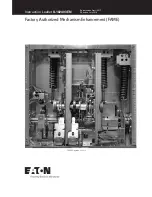
KRB-5200h
-29-
8.2 Inspection Procedures
In order to keep the intended performance and ensure safety of the ACB, it is necessary to inspect
the ACB at intervals recommended in the previous section.
For details of inspection procedures see the following tables.
Before inspecting the internal mechanism of the ACB, loosen the molded-cover fixing screws
and remove the cover.
When the ACB is equipped with the motor operator, remove the motor operator before
removing the cover.
For procedures for removing and mounting the operator, see
[3] Before and After Checking the
Trip Settings
,
XMD Series Motor Operator - Operating Instructions.
■
General
Inspection item
Tool/method
Criteria
Action/remedy
Looseness of
terminal screws
Try to tighten screws
with screwdriver or
wrench
No looseness
Retighten loose screws to the
torque specified in this manual.
Dust and/or foreign
materials
Visual check
No dust or foreign
materials on ACB
Remove dust or foreign materials
with a cleaner.
Wipe dust or foreign materials with
a clean and dry cloth.
Open/close
operation
Manual operation
with operating
handle or trip
button
Electrical operation
with UVT or SHT
Smooth
ON/OFF/Reset
operation
Replace ACB or, if identified, its
defective parts.
(Consult Terasaki for advice)
Crack, damage, or
discoloration on the
cover or mounting
base
Visual check
No crack or
damage
No discoloration
due to overheat
Replace ACB.
Insulation
resistance
500 V
insulation-resistance
tester
5 M
Ω
or more
If insulation resistance is less than
5 M
Ω
, replace ACB.
■
Main conductors
Inspection item
Tool/method
Criteria
Action/remedy
Roughness of
main-contact
surface
Visual check
Contact-resistance
tester (between I/O
terminals)
No wear and
roughness on
contact surface
No increase in
contact resistance
If internal resistance exceeds its
limit after several times of
open/close operation (see Table
4), polish contact surface with
emery paper.
If polishing does not decrease
internal resistance, replace ACB.
Roughness and/or
wear of arc horn or
arcing contacts
Visual check
Remaining thickness:
approx. 1/3
Polish contact surface to remove
roughness.
If thickness decreased to 1/3 or
less, replace moving or stationary
arc horn or arcing contact.
Looseness of arc
horn or arcing
contact fixing
screws
Try to tighten screws
with screwdriver or
wrench
No looseness
Retighten loose screws.
Summary of Contents for AME Series
Page 2: ...KRB 5200h ...
Page 6: ......
Page 32: ...KRB 5200h 26 5 3 Operation Characteristic Curves ...
Page 39: ...KRB 5200f ...






































